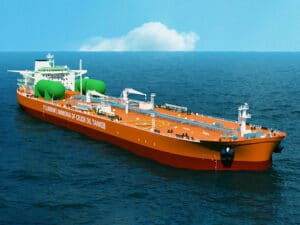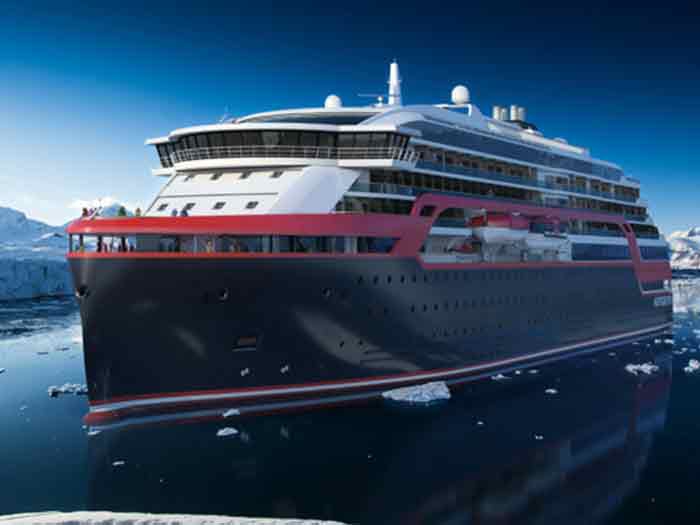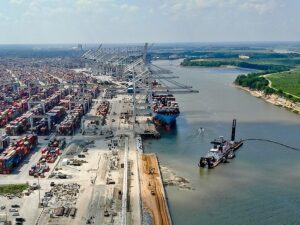
Hurtigruten newbuilds showcase green technology
Written by Nick Blenkey
NOVEMBER 22, 2016 — MS Roald Amundsen and MS Fridtjof Nansen, the Rolls-Royce designed 600 passenger expedition cruise ships on order at Norway’s Kleven shipyard for Hurtigruten, will feature a new and environmentally sustainable hybrid propulsion technology from Rolls-Royce.
The hybrid technology for is planned for delivery in two phases. In phase one, auxiliary battery power will provide large reductions in fuel consumption related to “peak shaving”. This solution is to be installed on the first expeditionary ship ready for delivery in 2018.
For phase two, larger batteries will be installed, enabling the possibility of fully electric sailing across longer distances and over longer periods of time. This will be used when sailing into fjords, at port and in vulnerable areas allowing silent and emission free sailing.
Rolls-Royce aims to install this new technology in ship number two, which is scheduled for delivery in 2019. The goal of Hurtigruten is also to refurbish ship number one with the same technology.
In addition to the hybrid power solution, the vessels will have the latest automation and control systems, including the Rolls-Royce Unified Bridge, the first delivery of two azipull propellers using permanent magnet technology, two large tunnel thrusters, stabilizers, four Bergen B33:45 engines, winches and power electric systems.
Mikael Makinen, Rolls-Royce, President – Marine, said: “The two new explorer cruise vessels for Hurtigruten represent somewhat of a dream project for us; delivering our latest technology innovations into beautifully designed and fit-for-purpose vessels.”
Daniel Skjeldam, CEO of Hurtigruten, said: “The future of shipping is, without a doubt, silent and emission free. We will use our new expeditionary ships as groundbreakers for this new technology and show the world that hybrid propulsion on large ships is possible, today.”
The decision to invest in a hybrid solution is an important milestone in Hurtigruten’s goal of sailing fully electric expeditionary ships in the Arctic and Antarctic.
Hybrid technology, in combination with the construction of the hull and effective use of electricity on board, will reduce the fuel consumption by approximately 20% and CO2 emissions by 20%.
“A passenger ship requires enormous amounts of energy to operate, and so far, there have been no technologies able to fulfil the requirements of a fully electric Hurtigruten ship. Hurtigruten’s new ships will probably be the first in the world,” said Mr. Skjeldam.
Another innovation is main propulsion thrusters that use integrated permanent magnet (PM) technology instead of being powered by separate propulsion motors. Over the last two years, Rolls-Royce has launched a range of propulsion and deck machinery driven by PM technology. From 2017 a new azipull model will be on offer, and this is the product specified as the main propeller units on board Hurtigruten.
Azipull thrusters with pulling propeller and streamlined underwater skeg have proved highly popular propulsion units since they were introduced in 2003. Over four hundred and fifty units have been manufactured by Rolls-Royce (in Ulsteinvik, Norway) to date.
With the introduction of electric drive through the use of permanent magnets, a proven Rolls-Royce technology is ensured a prolonged life, according to Knut Eilert Røsvik, Rolls-Royce, Senior Vice President – Propulsion: “We expect to see a shift from mechanical to electrical propulsion systems, and we are well positioned for this shift. We have invested in PM technology for more than ten years, and already have a lot of experience with it.”
The PM motor provides a very high efficiency over a wide speed range and reduces the space required in the thruster room. The propulsion system is well qualified for ships with ice class demand. Combined with the proven high propulsive and hydrodynamic efficiency of the azipull, this will be a winning combination.
Four Bergen B33:45 engines in combination with the use of batteries, comprise the cornerstones of the innovative hybrid solution onboard these Hurtigruten vessels. Since its launch in 2014, this medium speed engine has been chosen by a variety of owners and shipyards for a range of ship designs, with 50 engines now delivered or on order.
The engine offers 20% increased power compared to its predecessor, delivering the same output with fewer cylinders. This lowers the costs through the engine’s lifecycle, and also allows for smaller machine rooms on board.
The engine meets the international environment requirements for IMO NOx Tier III with support from a Selective Catalytic Reduction (SCR) system.
The vessels will have the latest automation and control systems, including the Rolls-Royce Unified Bridge — a complete redesign of the ship bridge environment, including consoles, levers and software interfaces.
Full Rolls-Royce scope of supply:
- Main Generating Sets: Four Bergen B33:45, each with scrubber system for removal of NOx
- Battery system
- Propulsion system comprising two Azimuth Thrusters – Azipull, with permanent magnet motor, and two tunnel thrusters.
- Remote control system
- Stabilizers, type Aquarius 100
- Dynamic positioning system, DP0
- ACON Integrated Automation System, including Acon Connect and Acon Energy.
- Unified Bridge including chairs, consoles and auxiliary bridge control
- Mooring winches and cable lifter units of electric frequency converter.
- Rolls-Royce Power Electric System, technology including generators, motors, switchboards and a Power Management System
- Design, basic design and detailed engineering






Leave a Reply
You must be logged in to post a comment.